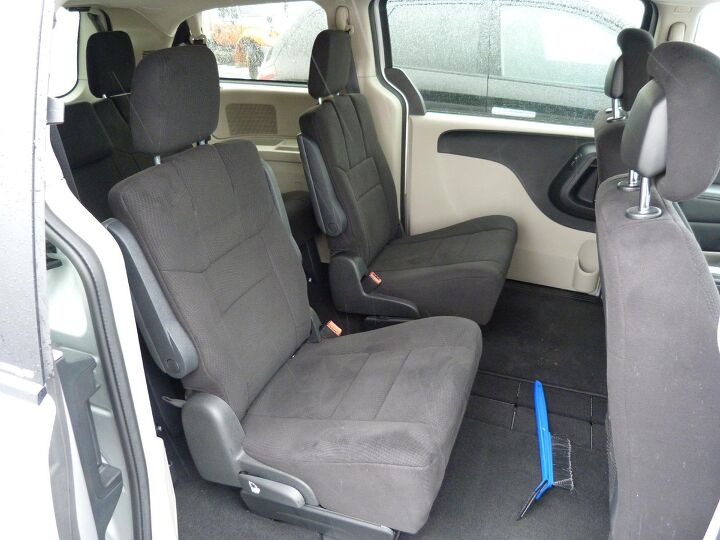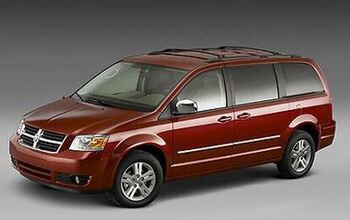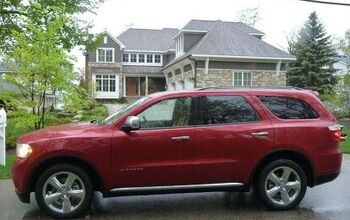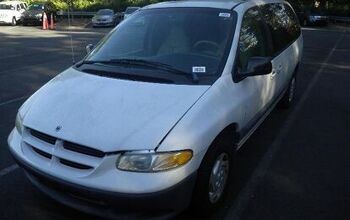Review: 2011 Dodge Grand Caravan
When Jack Baruth reviewed the 2011 Town & Country his praise for the minivan’s handling was so effusive that I wondered what sort of Kool-Aid Chrysler served at the launch event. Were mind-altering substances involved? To find out, I requested one of the new minivans for a week.
Some background: Chrysler substantially revised nearly every car and truck it sells for the 2011 model year, something which no manufacturer has attempted in decades. This in itself displayed a surprising amount of energy and ambition. FIAT will get the credit, but truth be told new parts cannot be tooled up overnight so these changes must have been underway before Sergio arrived on the scene. Cerberus, much maligned, is actually due the credit. How much could possibly have been done with Chrysler’s cut-to-the-bone staff stretched so thin and with the company bankrupt?
Given the limited budget and even more limited time, the Grand Caravan’s sheetmetal didn’t change. There’s the new Dodge grille and some nifty “ring of fire” LED tail lights, but the boxy—even for a minivan—exterior they attempt to dress up remains the same. I never could shake the feeling that I was driving a cargo van.
The interior was thoroughly redone. The new instrument panel upper remains hard plastic, but it’s now a single piece and doesn’t look shoddy the way the old one did. The door panels, which you’re much more likely to touch, are soft. The tested van was a $29,660 special, cleverly packaged to include key functional options (power doors, review camera, Bluetooth, multi-functional console, roof rails) for a sticker with a leading two. So no leather (or even seat adjustments beyond fore-aft and recline), though the cloth is much nicer than last year’s stain-resistant textiles. It further helps that blah gray has been exiled in favor of a high contrast black / gray combination. Even with the improvements the interior doesn’t seem as upscale as that in the new Honda Odyssey. One reason: Chrysler has done such a good job of designing for usability that the center stack looks plain. The center stack in the Honda isn’t as easy to reach or operate, but it looks more exciting. While functionality should matter more to buyers, will it actually matter more?
Even compared to that in other minivans the seating position in the Grand Caravan is high and upright. At this price point the seat height isn’t adjustable, not even manually. I wouldn’t want to raise it, but I might want to lower it. Visibility is outstanding, and confidence behind the wheel is inspired. But, in another test of how much functionality truly matters, it’s also harder to forget that you’re driving a minivan.
The cloth seats provide good lateral support, but lower back support is lacking and is not adjustable. Moving to the second row, the “stow-n-go” seats have been enlarged but they remain lower to the floor and less comfortable than the second rows in key competitors. They’re not bad, but wouldn’t be the best place for an adult to spend a few hours. Kids? No problem. Third-row comfort is more competitive, partly thanks to an aggressively angled seat cushion. There’s enough room for adults in all three rows, but the Sienna and especially the Odyssey are roomier. The official stats indicate a huge difference. While the Grand Caravan has 36.5 and 32.7 inches of legroom in its second and third rows, respectively, the Odyssey has 40.9 and 42.4. Such stats can be gamed, and these do appear to exaggerate the real-world difference between the two vans, but it is there.
The Grand Caravan has a clear advantage in cargo hauling versatility. Both the second and third rows stow completely beneath a low floor. In the Odyssey and Sienna the second-row seats must be removed to get a flat floor. The seats in the new Nissan Quest fold to form a flat floor, but on top of rather than beneath the floorpan, SUV style. As a result there’s much less space between the floor and ceiling. When the Dodge’s seats aren’t stowed there’s a deep well behind the third row and two large covered storage compartments ahead of the second row. In the past I’ve fit two large 17-inch laptops in their storage bags in one of these compartments. Up in the front seat there’s plenty of storage space in the bi-level removable center console, a pair of glove compartments, and the center stack. If you cannot tuck all of your stuff into the storage areas of this van, you’re schlepping too much stuff.
As part of its sweeping 2011 model year revisions, Chrysler installed an all-new V6 in its midsize sedans, large sedans, and SUVs in addition to the minivans. The “Pentastar” engine will get direct injection, FIAT’s “MultiAir” intake system, and even turbocharging in future iterations. Even without any of these technologies the 3.6-liter V6 is good for 283 horsepower at 6,400 rpm and 260 pound-feet of torque at 4,400 rpm. Both figures are the highest in the minivan class. Pair them with a six-speed automatic with short initial gearing, and the new Grand Caravan accelerates briskly. If it’s not the quickest minivan ever, it’s close.
Dip deep into the throttle and torque steer enters the picture—not a surprise given the amount of torque being channeled through the front wheels. Subjectively, the new V6 sounds and feels better when revved than any other minivan powerplant with the possible exception of the Toyota Sienna’s. The V6s from Ford and Nissan are considerably less refined. While the 3.6 really comes on strong (and then rushes for the redline) over 4,000 rpm, acceleration also feels effortless at much lower rpm in casual driving. By following everyone else in developing a contemporary V6 Chrysler could learn from everyone else, and seems to have done so.
The six-speed automatic transmission is a placeholder until Chrysler starts receiving a new nine-speed from ZF. The box is calibrated pretty well for full-throttle acceleration, with quick, firm shifts in this mode, but oddly slurs shifts in more casual driving. Hit the “econ” button on the center console and the transmission rushes to get into top gear. Unlike in other minivans you can manually select a specific gear. There are no paddles, but a gearshift just to the right of the steering wheel is the next best thing. Downshifts can be summoned without removing a hand from the wheel. Perhaps all automatic shifters should be positioned this way? A conventional column shifter isn’t nearly as handy.
Manually downshifting a minivan—what’s the point? Well, last year there wasn’t much of one, except perhaps in the mountains. The 2010 Town & Country I rented for a 1,500-mile trip last Thanksgiving bounced, floated, and generally felt ponderous and clumsy. Especially given this starting point, the handling of the 2011 is remarkable. The revised minivan has precise, firm, perfectly weighted steering and tightly controlled body motions. In comparison, other minivans, including the Odyssey, feel soft, and even sloppy. (Ditto the Ford Taurus X I recently purchased.) In a marked change from last year, the 2011 Grand Caravan feels smaller and lighter than it actually is. I found myself taking turns at speed for the joy of it—something I’ve never done in a minivan before. Bear in mind that this was in the “Mainstreet” trim level shod with 235/60R16 Kumho treads. There’s a sport-suspended R/T on the way, but the base suspension handles so well I have a hard time imagining how the R/T could handle better.
Instead, I fear that the R/T’s tuning will harm the ride. As it is, despite (or perhaps because of?) its aggressively damped suspension tuning the 2011 Grand Caravan also rides extraordinarily well. Pockmarked roads that have bedeviled most of the cars I’ve tested failed to faze this minivan. No pitch, no head toss, just level cruising regardless of the road surface. Impacts are heard, but not felt. A Sienna or Odyssey seems quieter and more luxurious, and so more like a luxury car, but they aren’t nearly this composed. Frankly, hardly anything is.
As mentioned earlier, the new Grand Caravan with key functional options lists for just under $30,000. You simply cannot get a Honda Odyssey with three power doors and a rearview monitor for anything close, as Honda forces you to step up to the leather-and-sunroof-equipped EX-L for these features. Compare the Mainstreet with power doors to the Odyssey EX, and you’ll find that the Dodge lists for a substantial $3,825 less. The Honda does include some additional features, such as a power driver seat and automatic climate control. But adjust for these (easily done using TrueDelta’s car price comparison tool) and the Dodge’s price advantage remains over $3,000. Toyota is a little more flexible—you can get a Sienna LE with dual power sliding doors and a rearview monitor, but for a power tailgate you need to step up to the SE or XLE. A Sienna LE with Preferred and Convenience Packages lists for only a few hundred more than a comparable Dodge, and if you compare invoices (which often more accurately reflect transaction prices) the Toyota is even about $900 less.
So, the Grand Caravan remains nothing special to look at. And other minivans are more comfortable. But the Dodge and its Chrysler counterpart lead the field in versatility and—with the recent changes—in performance and handling as well. How did Chrysler manage this, starting with a very basic suspension design (MacPherson struts up front, beam in the back) that did nothing especially well? Perhaps they cribbed some of the tweaks VW made for the Routan? If they’ve done the same with the rest of the line—and I can’t believe I’m saying this—there could even be hope for the Chrysler Sebring 200. Driving the revised minivan shifted my opinion of Chrysler all the way from “What’s the point of keeping them around?” to “Time to take the fork out.” Seemingly “done” a year ago, it’s now clear that a thoroughly revitalized Chrysler is just getting started.
Dodge provided the vehicle, insurance and one tank of gas for this review.
Michael Karesh operates TrueDelta, an online source of automotive pricing and reliability data.
Michael Karesh lives in West Bloomfield, Michigan, with his wife and three children. In 2003 he received a Ph.D. from the University of Chicago. While in Chicago he worked at the National Opinion Research Center, a leader in the field of survey research. For his doctoral thesis, he spent a year-and-a-half inside an automaker studying how and how well it understood consumers when developing new products. While pursuing the degree he taught consumer behavior and product development at Oakland University. Since 1999, he has contributed auto reviews to Epinions, where he is currently one of two people in charge of the autos section. Since earning the degree he has continued to care for his children (school, gymnastics, tae-kwan-do...) and write reviews for Epinions and, more recently, The Truth About Cars while developing TrueDelta, a vehicle reliability and price comparison site.
More by Michael Karesh
Latest Car Reviews
Read moreLatest Product Reviews
Read moreRecent Comments
- MaintenanceCosts This is probably as good as B5.5's get, but keeping it that way is going to be very very expensive, and for all that money you won't even have three pedals.
- Urlik Peak Passat.
- Cla65786503 Do the esses at Riverside International Raceway count as a corner?
- El scotto Do the Agnellis care about any of this?
- El scotto Wait! What are these higher-level Kias you write about?


















































Comments
Join the conversation
I have purchased a 2011 Grand Caravan.I had 3 Vans before this all Chev. without any major problems. I had always stayed away from Chrysler because of their transmission problems. I went against my better judgement and purchased this vehicle,and wish that I hadn't. There are a lot of things to like about this Van. but are weighed down by noisy brakes,play in the driveline when putting the Trans. in drive which results in an annoying clunk,rough change between 1st. and second gear, and surging from the Trans. when in reverse on a hill.I have brought these problems to both the dealer and Chryslers attention without any resolve yet.Am I sorry I didn't keep my Chev. This is unbelieveable for a new vehicle.I couldn't recommend a Caravan to anyone.
These dodge vans are horribly designed for air intake and my 2013 grandcaravan has been a nightmare my 99 02 and 07 were alright besides slipping Trans in 07. Here's what happened to me. I had misfires every couple days or so more when it rained the dealer tried fixing it. They changed all sensors still nothing, after 6 months of loaners and rentals I got my van back because they could not figure it out. I was on my way back from a trip when the van started misfiring again I was only a minute from home. I got in my driveway and the van died. I called dealership next day for them to tow it. I call them about 2 weeks later asking if they are fixing it, they said the engine is being replaced. I get a call 2 days later saying fca asked them to take pics of air box and intake. The manager found this odd because he's never had to take pics of this area to change an engine. When the airbox was taken apart they found water in the air intake. They won't warranty the engine. The air intake is 18 inches from the ground in the front bumper. So the misfires were moisture and on the way back from my trip it was raining there was a moderate puddle near the shoulder of the road and somehow splashed enough water to fry the motor. What a poor design. Before anyone says anything negative about this there are several people with exact issue, 20 cars ahead of one person in 2011 caravan all the cars went through moderate puddle all kept driving but the caravan dies. These vans are poorly made last dodge ever owned.